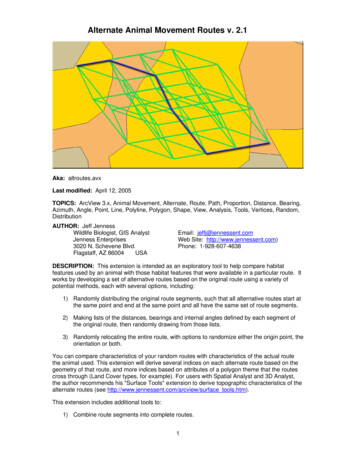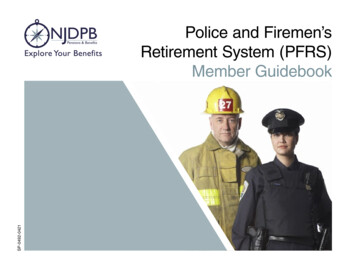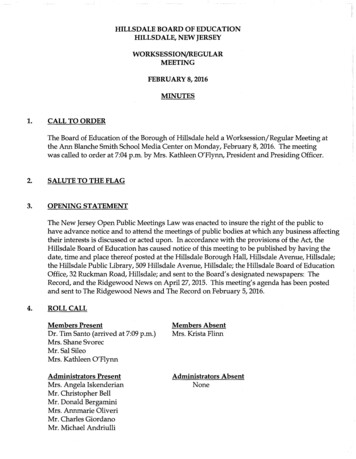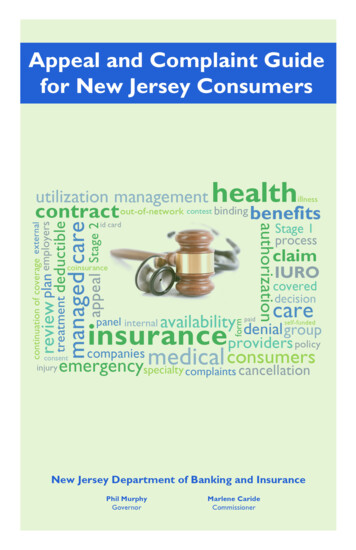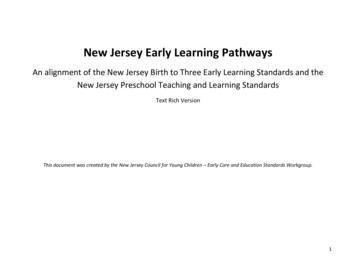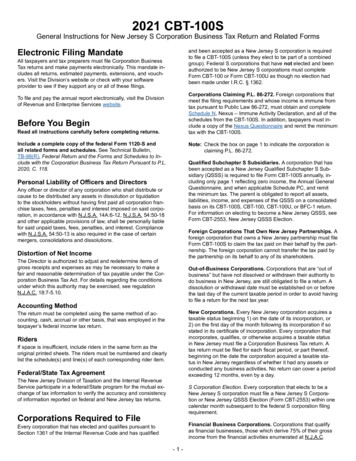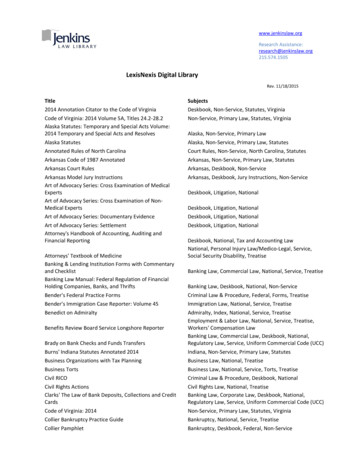
Transcription
New Jersey’s “Alternate Route”to Teacher Certificationby Leo KlagholzJANUARY 2000
Growing Better Teachersin the Garden State:New Jersey's "Alternate Route"to Teacher CertificationbyLeo Klagholz
Table of ContentsList of Figures .iiiForeword .vExecutive Summary .viiIntroduction.1Reform of Undergraduate Teacher Preparation .1Development of an "Alternate Route" Proposal.3Political Reaction and Compromise .7Use of the Provisional Teacher Program by New Jersey Schools .11The National Teacher Shortage Debate .19Appendix.22Growing Better Teachers in the Garden Statei
List of FiguresFigure 1Number of Provisional Teachers Hired by New Jersey Schools (1985-1990) . . . . . . . . . . . . . . . . .11Figure 2Number and Proportion of Provisional and Traditionally Prepared TeachersHired for September by New Jersey Public Schools (1985-1990) . . . . . . . . . . . . . . . . . . . . . . . . .12Figure 3Fields of Employment of New Jersey Provisional Teachers (1985-1990) . . . . . . . . . . . . . . . . . . . .13Figure 4Numbers of NJ Public School Districts By District Factor GroupEmploying Provisional Teachers in September (1985-1990) . . . . . . . . . . . . . . . . . . . . . . . . . . . . . . . 14Figure 5Mean NTE Scores of New Jersey Provisional Teacher ProgramApplicants and NJ College Teacher Education Graduates (1985-1989) . . . . . . . . . . . . . . . . . . . . .15Figure 6Numbers of "Alternate Route" Teachers Hired Annually forSeptember by Public and Nonpublic Schools, and Percentages ofNew Public School Teachers Represented by "Alternate Routers" (1985-1998) . . . . . . . . . . . . . . .17Growing Better Teachers in the Garden Stateiii
ForewordIf you've read any of this Foundation's other recent publications about teachers and teacher quality, youalready know that we're fans of alternative certification. Today more than forty states offer suchprograms. The best of them provide compressed basic training for prospective teachers without forcinglengthy detours through colleges of education, and allow qualified candidates for teaching posts tobypass most of the hoops and hurdles that so often deter talented people from public school classrooms.Alternative certification was essentially invented in 1983, when New Jersey introduced its pathbreakingplan. In this report, Leo Klagholz, the Provisional Teacher Program's original architect, outlines itsaims, the debates that attended its birth and growth, the results it has had so far, and some lessons forother states. What's especially noteworthy about the alternative certification program depicted in thesepages is that it was designed not to respond to a teacher shortage but as part of a broader effort to boostteacher quality in the Garden State. The evidence presented here suggests that it has done exactly that.Dr. Klagholz knows the story of alternative certification better than anyone and we were thrilled whenhe agreed to write this report. A life-long educator, at the time he crafted New Jersey's ProvisionalTeacher Program he was Director of Teacher Preparation and Certification in the state's Department ofEducation, serving under Commissioner Saul Cooperman and Governor Tom Kean. In more recentyears, he himself served as New Jersey's Comissioner of Education under Governor Christie Whitman.Today, Leo is a Distinguished Scholar in Educational Policy Studies at The Richard Stockton Collegeof New Jersey. Readers wishing to contact him directly may call him at 609-652-4521, write to him atRichard Stockton College of New Jersey, Jim Leeds Road, Pomona, NJ 08240-0195 or send an e-mailto Leo.Klagholz@stockton.edu.The Thomas B. Fordham Foundation is a private foundation that supports research, publications, andaction projects in elementary/secondary education reform at the national level and in the Dayton area.Further information can be obtained from our web site (http://www.edexcellence.net) or by writing us at1627 K St., NW, Suite 600, Washington, D.C. 20006. (We can also be e-mailed through our web site.)This report is available in full on the Foundation's web site, and hard copies can be obtained by calling1-888-TBF-7474 (single copies are free). The Foundation is neither connected with nor sponsored byFordham University.Chester E. Finn, Jr., PresidentThomas B. Fordham FoundationWashington, D.C.January 2000Growing Better Teachers in the Garden Statev
Executive SummaryIn September 1984, the New Jersey Board of Education launched the Provisional TeacherProgram, the nation's first alternative teacher certification program, which was part of thestate's broader effort to boost the quality of its teaching force. The "alternate route," as itcame to be known, emerged from a reform process initiated after a commission created bythe legislature concluded that New Jersey's teacher preparation programs were producingpoorly educated graduates.In response, the state embarked on a dual path of reform: improving the quality ofundergraduate teacher preparation while also creating the Provisional Teacher Program asan alternate pathway into the profession. The traditional route was reformed by reducingthe number of required education courses; this came after a study conducted by the state'sDepartment of Education found that most such courses were superfluous. That studyidentified a core body of applied knowledge to which every new teacher ought to beexposed, but effective teacher preparation was redefined as a combination of a solid liberalarts education and mentor-assisted practice teaching.At the same time, the state established an alternative system through which school districtscould recruit talented individuals with liberal arts backgrounds who had not studiededucation in college. The alternate route candidates would develop their teaching skills inessentially the same way as traditional candidates: by teaching with the support of amentor. Formal instruction in a core of applied teaching knowledge could take placeduring the novice teacher's first year of employment rather than in college; indeed,receiving this instruction in conjunction with mentor-guided practice was thought to beessential. Ultimately, the state's new certification regulations established parallelrequirements for the alternative and traditional routes, yet the former remains a truealternative: only 200 clock hours of formal instruction in teaching methods are required.According to the author, New Jersey's alternative certification program has markedlyexpanded the quality, diversity, and size of the state's teacher candidate pool. By 1998-99,457 school districts had utilized the program. Applicants had higher scores on teacherlicensing tests than traditionally prepared teachers and attrition rates for alternatively certified teachers were lower than those of their traditionally trained counterparts. TheProvisional Teacher Program also became the dominant source of minority teachers for bothurban and suburban schools.Growing Better Teachers in the Garden Statevii
IntroductionSeptember 1999 marked fifteen years sincethe establishment of the New Jersey ProvisionalTeacher Program, the state's "alternate route" toteacher certification. Since then, New Jerseyschools have used the program to hire and trainnearly 7,000 new teachers. The program, whichis now an integral part of the state's teacheremployment system, has helped account for thefact that, since 1985, New Jersey has not issueda single emergency certificate in any of theaffected teaching fields. Nor has it had toauthorize the employment or reassignment ofany teachers outside their subject fields. Farmore importantly, the program has achieved itsprimary purpose of enhancing the overall qualityof the state's teacher candidate pool.Reform of Undergraduate Teacher PreparationNew Jersey's "alternate route" enjoyswidespread acceptance largely because it wascreated as part of a broader effort to enhanceteacher quality. That effort began with initiativesaimed at improving the quality of undergraduateeducation degrees by reducing pedagogy coursesin favor of increased liberal education and practice teaching requirements. This reform of the"traditional route" paved the way for the "alternate route" program because it fundamentallyredefined the "well-prepared teacher" as someonewith a liberal arts degree who acquires teachingskill mainly through actual classroom practice.Commission to Study TeacherPreparation ProgramsConcern over the quality of public educationand teaching reached a peak in the 1970s whenthe former state teachers colleges were required toconvert to liberal arts-based institutions as part ofa restructuring of the higher education system.This conversion brought the curricula of teachereducation programs under intense public scrutinyand criticism.In 1978, the State Legislature created theCommission to Study Teacher PreparationPrograms in New Jersey Colleges (CSTPP),comprised of legislators, state education officials,educators and private citizens. The Commission'spurpose was to "conduct a study of teacher preparation programs at New Jersey colleges becauseof dissatisfaction with the quality and scope of theprograms for the education of teachers in this stateand the requirements for licensing (CSTPP, FinalReport, June 1981)." The CSTPP conducted anexhaustive review of undergraduate preparationprograms and concluded that they were producingpoorly educated graduates.The Commission's inquiry revealed that statecertification mandates had produced a proliferation of education courses and programs in circumvention of the campus-based processes that colleges use to assure the quality of academic offerings. In public hearings, higher education leaderscriticized these courses as generally unchallengingand lacking in substance. Teachers claimed thatthey did not contribute significantly to their classroom success.Yet education courses comprised as many aseighty credits in a 120-credit teaching degree.Prospective teachers not only majored in education, they also took education-based "hybridcourses" to satisfy liberal education requirements—e.g., "Math Concepts in the ElementaryClassroom" in place of the more rigorous, standard math courses that other students wererequired to take. Thus, elementary teaching can-Growing Better Teachers in the Garden State1
didates were able to graduate without havingExercising its authority over college degreetaken a single substantive course in science, math programs, the State Board of Higher Educationor history. Prospective secondary teachers comtook the lead in implementing the Commission'spleted specialized, sometimes hybrid, subjectrecommendations. It convened a Blue Ribbonmajors—e.g., "science education" instead ofPanel on Teacher Education, chaired by Pennphysics or chemistry.sociologist Ivar Berg and including then-AERASome members of the Commissionpresident Frank Farley and Stanford professorquestioned whether the traditional teacher prepaRalph Tyler. The panel endorsed the CSTPPration curriculum contained sufficient academicrecommendations and expanded on their rationale.substance to justify the award of a college degree. On that basis, the higher education board requiredThe Commission's study also suggested that,all undergraduate education programs to include:due to their poor academic reputation, education(1) approximately sixty credits of "pure" liberalprograms and courses attracted weak students.education courses, distributed among relevant disThe State Department of Higher Education report- ciplines; (2) a liberal arts or science major comed that for several consecutive years, the SATprised of courses taken by liberal arts majors inscores of New Jersey high schoolthe same field; and (3) progresgraduates who indicated educasively intensive practice teachingElementarytion as their intended majorexperiences, beginning with ateachingranked 22nd among 23 collegebrief introductory sophomorecandidates weremajors. A high proportion wasexperience and culminating in theabletograduatefound to be deficient in basicsenior year with a semester of fullwithout havingskills on the statewide test fortime student teaching. Given thetaken a single subentering college freshmen.requirement that certification canHowever, despite their weak acastantive course indidates major in the liberal arts,demic prowess, few educationthe higher education board alsoscience, math orstudents washed out of theirdirected colleges to cease awardhistory.preparation programs.ing undergraduate degrees in theBased on testimony providedfield of education, except whereby teacher representatives, the Commission found education is the secondary emphasis in a dualthat "practice teaching," performed in schoolmajor.classrooms under the guidance of a school-basedThese changes, which were aimed at improvmentor teacher, was the most valuable aspect ofing new teacher quality, redefined effective "tradiprofessional preparation.tional" preparation as a combination of liberaleducation and mentor-assisted practice teaching.Regulatory ReformsThus, it was not a large step to establish a parallelsystem through which school districts couldThe CSTPP concluded that beginningimprove teacher quality by recruiting other liberteachers must, first and foremost, be educatedally educated individuals who did not study edupersons. It recommended that undergraduatecation in college. These "alternate route" candidegree programs enrolling certification candidates dates would develop their instructional skills inbe required to include a substantial liberal arts orthe same way students in the reformed "traditionalgeneral education component, a liberal arts or sci- route" would: by actually teaching in a schoolence major, and expanded practice teachingclassroom with support from a mentor teacher.requirements.2Leo Klagholz
Development of an "Alternate Route" ProposalYet the state did not simply conceive of andpropose such a program. Instead, the "alternateroute" evolved from a study conducted to determine the place of education courses in thereformed traditional preparation programs.been rejected though they had job offers in hand,and an analysis of the certification requirementsthat caused their rejection.Third, the CSTTP had previously planted theseed for the idea of an "alternate route." Although it did not analyze individual certificationCertification Studycourses, its members struggled, without reachingagreement, with the general problem of what toThe Department of Education had todo with education study in the new liberal artsconduct such a study because the question ofbased preparation programs. It recommendedwhich, if any, education courses should be includ- requiring the new degrees to incorporate threeed was unresolved. While the CSTPP's inquiry"pure" liberal arts courses in the behavioral/socialproduced criticism of education courses in genersciences, and the higher education board's regulaal, it did not assess individual courses.tions incorporated such a mandate. Higher educaThere were three reasons why the Department tion representatives generally favored movingof Education's study of educationeducation study, per se, to the gradcourses in the "traditional" collegeuate level, but teacher union repreIt was not a large steproute also led to a proposal of ansentatives argued that teachingto establish a parallel"alternate route."competence could be acquiredsystem through whichFirst, the study was a continuathrough means other than a graduschool districts couldtion of a long-term search for waysate education degree. Attempting toimprove teacherto improve teacher quality that sosatisfy polar positions, the CSTPP'squalitybyrecruitingfar had generated harsh criticism offinal report advanced the idea ofotherliberallycertification mandates and firmlymoving requisite education study toeducated individualscommitted the state to a strategy ofthe graduate level but asserted thatwho did not studydramatically expanding the liberalthere would be " situations inand practical education of teachers.which it would be unreasonableeducation inTherefore, the certification studyand undesirable to require complecollege.was necessarily oriented and pretion of a [preparation] program indisposed toward weeding out weak and unnecesthe prescribed way." Thus, the CSTPP urged thatsary education course requirements." equivalency routes to certification must beSecond, while higher education officials hadprovided." In the Commission's view, such adefined the teacher quality problem primarily inroute would involve an assessment of individualterms of the academic adequacy of collegecandidates' knowledge, teaching skills and persondegrees, the state education commissioner and his al qualities in the manner of an external degreestaff approached it mainly as a human resourceprogram.issue. They hypothesized that school districtsThe idea of requiring all teachingwere being prevented from employing capablecandidates to obtain a generic master's degree inteaching candidates simply because they lackededucation was never taken seriously, mainlythe very courses that had been the subject of harsh because of the contradiction inherent in creating acriticism over the previous five years. Therefore, graduate degree out of course content deemedtheir study included a review of certification filesgenerally unworthy of undergraduate credit.to identify individuals whose applications hadHowever, the basic idea of creating an "equivalenGrowing Better Teachers in the Garden State3
cy route" through which to meet certificationrequirements was "on the table" when the stateeducation department began its internal review ofcertification mandates.dents would take the proposed subject test aftergraduation and prior to receiving certification.Certification Reform ProposalThe education department's review of rejectedcertification applications had confirmed itshypothesis that many individuals with outstandingacademic qualifications and pertinent experiencewere being barred from employment for lack ofseemingly trivial courses. Therefore, the department's report went on to state:"Alternate Route" ProposalIn September 1983, the educationdepartment issued its report. It discussed theurgent need to improve the quality of public education and the related importance of "attracting tothe teaching profession men and women ofoutstanding talent and academic achievement."There is a need to provide an alternateIt concluded that many of the then-existingroute to certification for those who possesseducation course mandates failed to achieve thata degree but have not completed an internresult because of their "limited effectiveness asship, and thereby open the doors of thepredictors of competence." It asserted that "anyteaching profession to talented personsnew requirements should be concerned withfrom all collegiate fields of study .[Therefore] for those who majored in theprocess (courses taken) only in the most generalliberal arts the internship could be prosense and must instead emphasize the assessmentvided after graduation by a local [school]of each individual candidate."district.To that end, the report urged theA candidate would qualify for theState Board of Education to replace A candidate wouldqualifyforthe"alternate route" if he or she posits existing course mandates withsessedthe same academic qualifica"alternate route" ifthree basic certification requiretions required of students in the newments that were compatible withhe or she possessed"traditional route": a baccalaureatethe already-adopted preparationthe same academicdegree with a major in the teachingprogram reforms. Specifically,qualificationssubject and a passing score on aeach certification applicant wouldrequired of students subject matter test. The individualbe required to: (1) obtain a bacin the newwould also have to obtain a jobcalaureate degree with a major in"traditional route.” offer from a local school districtthe subject to be taught; (2)that had examined his or her experidemonstrate subject competency byence, background and personal qualities. Oncepassing the relevant subject test of the Nationalemployed with full salary under a one-year proviTeachers Exam (NTE); and (3) acquire andsional certificate, the "alternate route" teacherdemonstrate teaching skill by completing a menwould receive support from a mentor teacher durtor-assisted, school-based internship.ing the initial year while completing in-serviceAgain, these requirements were nottraining. School staff would monitor and evaluateproposed as an "alternate route" but rather asthe teacher's development and classroom performuniversal standards that all certification candidates ance, and recommend at the end of the yearshould be required to meet—primarily students in whether or not the state should issue standard certhe redesigned undergraduate preparation protification.grams. For such students, the new practice teachRationaleing requirement, spread out over the sophomore,junior and senior years, would constitute theThe logic of the education department'sschool-based internship. Preparation program stu- proposal, and its eventual acceptance across the4Leo Klagholz
state, are rooted in its unique treatment of the roleof teacher training in the broader system ofteacher preparation and employment.The department's study did indeed concludethat most existing education courses—some withtitles like "Discovering Your Teaching Self,""Descriptive Linguistics," and "Revolutions inEducation"—were superfluous and should be jettisoned from state regulation. Yet it did not contend that all education study was valueless. Onthe contrary, it asserted the existence of a corebody of "applied" knowledge—i.e., how-to-teachknowledge—to which each new teacher ought tobe exposed. Yet it also concluded that permittingsuch exposure to occur during a teacher's firstyear of employment would be: (1) an acceptableway of training the individual novice; and (2) asuperior approach to assuring the overall qualityof the teacher candidate pool.of "how to teach" generally. Such formal instruction is most beneficial, though, when provided inconjunction with mentor-guided practice so thenovice can use it to analyze, solve and generalizefrom the real-world teaching problems he or she isencountering. The importance of this integrationof "learning and doing" renders unsound anynotion of separating formal instruction in appliedknowledge from mentor-guided practice. Giventhe minimal difference between acquiring suchexperience in a college program and doing so during the initial months of actual employment, it isacceptable for new teachers to receive formalinstruction in applied knowledge in conjunctionwith a district-run, job-based internship. Indeed,it would be ineffective to require "alternate route"teachers to complete education study in advanceof their employment-based internship.Quality of the Teacher Candidate PoolTraining of the Individual NoviceNovice teachers gain teaching ability mosteffectively by practicing in a school classroomwith advice and guidance from a veteran teacher.It makes no important difference whether a noviceengages in mentor-assisted practice through a college preparation program prior to employment orduring the initial months of full-time salariedemployment. Indeed, doing so "through a collegeprogram" means that the college places the aspiring teacher in a school classroom where he or sheassumes full instructional responsibility as soon aspossible with support from a teacher employed atthe school. In both the employment-based andcollege-based scenarios, the new teacher learns byinstructing real students in school classrooms, andthe mentor is the primary control against the factthat the teacher is a novice.It is also useful for novice teachers to receiveformal instruction in applied professional knowledge. This aspect of training gives them theopportunity to interact with and learn from a mentor who is not only a master of daily job functioning, but also an expert in the accumulated wisdomThe fact that it makes sense to instruct noviceteachers in applied teaching knowledge does notjustify the simplistic use of teacher training as arigid legal control over employment eligibility.To assure the quality of the teacher candidatepool, government-imposed eligibility requirements must provide job access to competentcandidates and deny it to incompetent ones. Staterequirements inhibit teacher quality if they eitheradmit people who are unlikely to succeed orscreen out potentially successful individuals.Setting aside the artificiality of the distinctionbetween "pre-employment" and "co-employment"training, requisite teacher preparation—i.e., mentor-guided practice combined with instruction inapplied professional knowledge—does not meetthe test of an effective pre-employment screen.The problem is that basic "how to teach"knowledge is not a hard science like physics orbiology. It is more like parenting psychology. Abody of information exists and is clearly worthconsidering. However, doing so in advance doesnot guarantee long-term success, nor does failureto do so necessarily doom one to failure. That isGrowing Better Teachers in the Garden State5
because teaching ability is also influenced byteaching jobs. Countless numbers of thesequalities commonly possessed by individuals who systematically recruited "emergency" teachershave not completed formal teacher preparation,have developed into very successful teachers.such as knowledge of subject matter and personalIn view of the preceding rationale, it is a mythtraits like intelligence, human sensitivity and car- that the New Jersey "alternate route" is built uponing, communication ability, work ethic, self-disci- the idea that it is useless to require new teacherspline, ability to relate to children, etc. As ato consider intellectually the accumulated wisdomresult, when government uses teacher training asof the profession. Colleges and private schoolsa formal job eligibility screen, it produces thethat do a good job of induction do this on theirdouble error of failing to guarantee the compeown, arranging institutes and seminars for theirtence of those who meet requirements while alsonew faculty members and referring them to coneliminating many individuals who haveferences and courses. It is reasonable for thesignificant capabilities.state to assure that these things are done in theFor those reasons, an "alternate route" is notpublic school system. Yet it is equally false toonly an acceptable option from the perspective ofview the New Jersey program's inclusion of edutraining the individual novice, it iscation training as an affirmation ofa superior means of assuring theIt would bethe appropriateness or necessity ofdepth and breadth—and thereforeineffective tousing such training as a strict prethe quality—of the talent pool.require "alternateemployment eligibility screen.In advancing these ideas, theroute" teachers toInstead, the program is foundedstate education department citedcomplete educationon the idea that teacher quality istwo pieces of prima facie evidenceof their workability.study in advance of best attained if the core body ofFirst, few private schools andapplied professional knowledge istheir employmentvirtually no colleges or universitiesstripped of its trivial excesses andbased internship.limit their hiring of new facultyused only to supplement themembers to those who have completed teacherbeginning teacher's mentor-guided induction toeducation. (Even collegiate schools of education the classroom. It is unimportant whether thedo not do so.) On the contrary, thesenovice teacher is placed in a school classroom byinstitutions select most of their new instructorsa college preparation program before graduationfrom among those who lack such training. Yetor by a school district afterward, as long as menthey succeed.toring support is available. To underscore thisSecond, while the public education system hascore argument, the Department of Education'stypically required pre-employment education1983 proposal cited the following statement bystudy, it has also maintained the loophole ofJames B. Conant:"emergency certification" so that school districtsExcept for practice teaching and the specan hire people who lack it. In New Jersey,cial [methodological] work combined withemergency certification had become so lax as toit, I see no rational basis for a state preencourage employing and reassigning teachersscription of the time devoted to educationoutside their subject fields. Yet public schoolcourses .[Methodology] should be madeadministrators also frequently contrived localavailable at the moment the potential"teacher shortages" so they could get aroundteacher most needs all the useful knowlcertification requirements and hire subject-eduedge he can get; that is, when he actuallybegins to teach (The Education ofcated individuals who lack
New Jersey's "Alternate Route" to Teacher Certification by Leo Klagholz. . Alternative certification was essentially invented in 1983, when New Jersey introduced its pathbreaking plan. In this report, Leo Klagholz, the Provisional Teacher Program's original architect, outlines its

